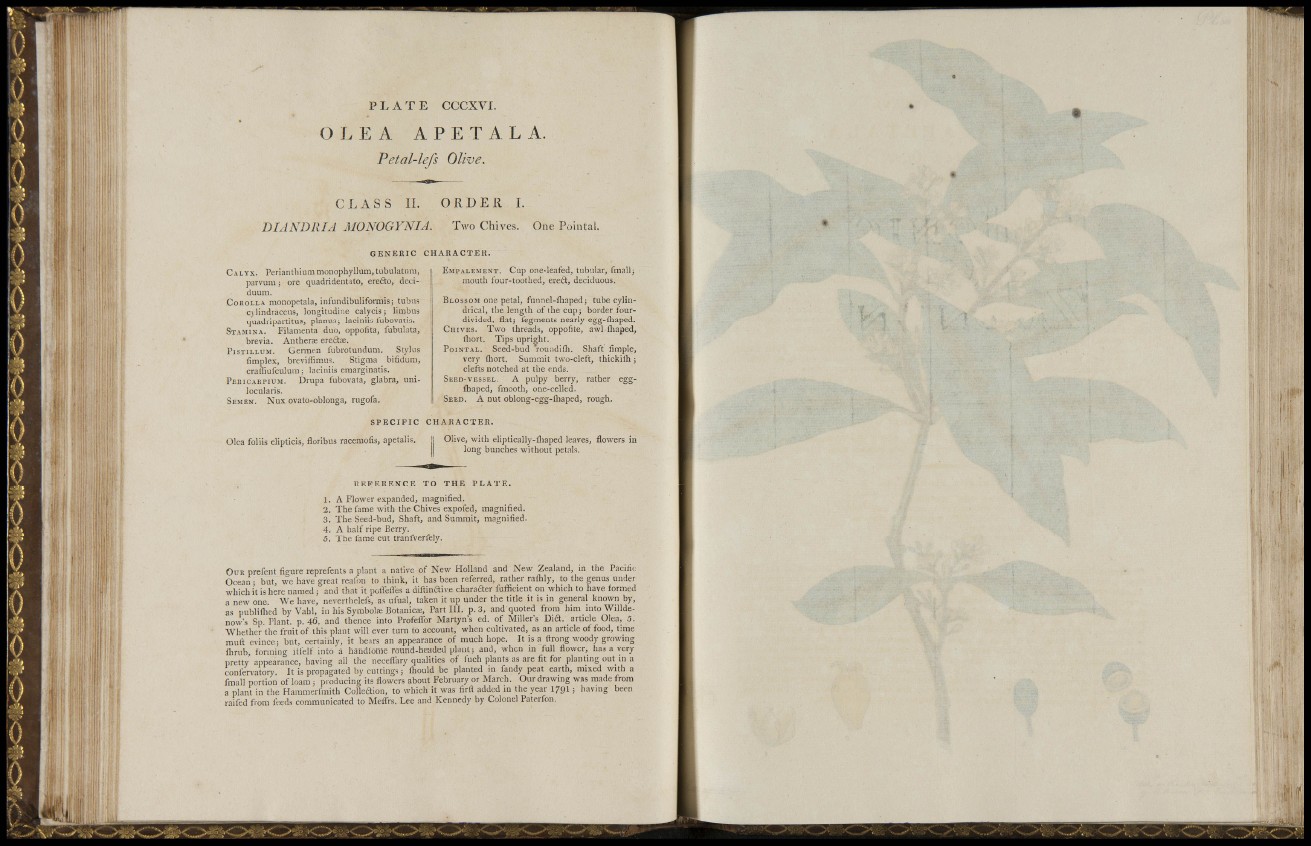
lili
s
! ' •
l ' i !i f
l i !i
1. n
ît
P L A T E CCCXVI.
O J. E A APETALA.
Petal-lefs Olive.
C L A S S IL ORDER L
DIANDRIA JMONOGYNIA. Two Chives. One Pointai.
GENEKIC CHARACTER.
CA LYX. Perianthium monophyllum, tLibulatiira,
parvum ; ore qiiadridentato, erefto, decicluum.
COROLLA monopetala, infundibuliformis; tubus
C) lindraceus, longitudine calycis; limbus
quadripartitus, planus; laciniis fubovatis.
STAMINA. Filamenta duo, oppolita, fubulata,
brevia. Antheras ereiSlaì.
PISTILLUM. Gennen lubrotundum. Stylus
(implex, breviffimus. Stigma bifidum,
craffiufculura ; laciniis emarginatis.
FEEICARPIUM. Drupa fubovata, glabra, uuilocularis.
SEMEN. NUX ovato-oblonga, rugofa.
EMPALEMENT. Cup one-leafed, tubular, fmali;
mouth four-toothed, ereft, deciduous.
BLOSSOM one petal, funnel-iliaped; tube cylindrical,
the length of ihe cup; border fourdivided,
flat; fegments nearly egg-fliaped.
CHIVES. TWO threads, oppofite, awl fliaped,
fliort. Tips upright.
PoiNTAL. Seed-bud roundifli. Shaft fimple,
very fliort. Summit two-cleft, thickiih ;
clefts notched at the ends.
SEED-VESSEL. A pulpy berry, rather eggfliaped,
fmoodi, one-celled.
SEED. A nut oblong-egg-fliaped, rough.
S P E C I F I C CHARACTER.
Olea foliis elipticis, floribus racemofis, apetalis. Olive, wi t h eliptically-iliaped leaves, flowers in
long bunches without petals.
REFERENCE TO THE PLATE.
1. A Flower e.xpanded, magnified.
2. The fame wi t h the Chives expofed, itiagnified.
3. The Seed-bud, Shaft, and Summit, magnified.
4. A half ripe Berry.
5. The fame cut tranfverfely.
OUR prefent figure reprefents a plant a native of New Holland and New Zealand, in the Pacific
Ocean • but, we have great realon to think, it has been referred, rather raflily, to the genus under
which it is her e named; and that it polTefles a di f t inaive character fufficient on which to have formed
a new one We have, nevertlielefs, as ufual, taken it u p under the title it is in general known by,
as publiflied byVahl, in his Symbola; Botanicae, Part III. p. 3, .and quoted from him mto Willdenow's
Sp. Plant, p. 46, and thence into Profeflbr Martyns ed. of Miller's DID. article Olea, 5.
W h e t h e r the fruit of this plant will ever turn to account, when cultivated, as an article of food, time
muft evince; bnt, certainly, it bears an appearance of much hope. It is a flrong woody growing
llirub, forming itfelf into a handlome round-headed plant; and, when in full flower, has a very
pretty appearance, having all the neceffary qualities of fuch plants as are fit for planting out in a
confervatory. It is propagated by cuttings; ihould be planted in fandy peat earth, mixed with a
fmall portion of loam ; producing its flowers about February or March. Our drawing was made from
a plant in the Hammerfmith Colleaion, to which it was firtl added in the year 170I ; having been
raifed from feeds communicated to MelTrs. Lee and Kennedy by Colonel Paterfon.
Î
• i :
'I
i
;
, I
iir:
; !
I t ;
• ! .